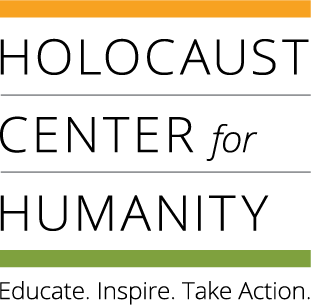 Image: Peter Metzelaar (front center) and his kindergarten class. Circa 1941. Amsterdam, The Netherlands. More about Peter.
Image: Peter Metzelaar (front center) and his kindergarten class. Circa 1941. Amsterdam, The Netherlands. More about Peter.
Common Core State Standards addressed by this Overview Lesson
Changing World
Defeated in World War I, Germany fell into a deep economic depression. Promising a return to strength and prosperity, the radical National Socialis t Party (Nazis) gained popularity. Adolf Hitler and the Nazis implemented a policy of racism, hatred, intimidation, and violence.
In the early 1900s, antisemitism became a central theme in a number of political parties whose leaders blamed Jews for the social and economic problems following the loss of World War I. Antisemitism is the hostile belief or behavior toward Jews just because they are Jewish. Antisemitism had existed for centuries in Europe.
The Nazis defined Jews as a race. Germans were seen as “superior,” and Jews, at the bottom of the scale, were the most dangerous. The Nazis also targeted gay men, people with mental and physical disabilities, Roma/Sinti, Jehovah’s Witnesses, Afro-Germans, and Poles.
Adolf Hitler founded the Nazi party in Germany in 1919. As the depression following World War I deepened, Hitler’s popularity increased. In 1930, the Nazi party won 107 seats in the Reichstag, the German legislative body. In 1933, Hitler was appointed Chancellor of Germany. His first 100 days in power were marked by mass arrests, suppression of free speech, the opening of the first concentration camps, and the purging of all political opponents.
The Nuremberg Laws, passed in 1935, stripped Jews of German citizenship, removed them from public office, outlawed marriages between Jews and non-Jews, and defined a Jew as “a person with two Jewish parents, or three or four Jewish grandparents.”
On the night of November 9, 1938, throughout Germany and Austria, the Nazis destroyed 267 synagogues, smashed windows of Jewish-owned stores, and arrested 30,000 Jewish men. This event, known as Kristallnacht (the Night of Broken Glass), marked a transition to an era of destruction and genocide.
Testimony Clips:
Holocaust survivors who made their homes in Washington State: Eva Tannenbaum Cummins, Fred Kahn, Klaus Stern, and Nora Eilenberg. See more video clips, photos, and biographical information on these survivors (and others) in the Survivor Encyclopedia: Washington State.
Questions
- Based on the information in this article and what you can infer, why do you think Hitler and the Nazis gained increasing popularity?
- What are some things Hitler and the Nazis did to gain complete, total control of Germany and its people?
- What was Kristallnacht, and why is it significant to the Holocaust?
- In Fred Kahn’s video clip testimony, he recounts how his town’s burgermeister (mayor) came to his father’s defense against the Nazi S.S. officers on Kristallnacht. In contrast, Klaus Stern’s best friend, Walt, refused to play with him anymore – because Klaus was a Jew and Walt was not. How do you explain why some non-Jews helped defend and protect Jews and others disassociated themselves from them, did nothing, or acted directly against Jews?
- Explain how the video clip testimony of Eva Tannenbaum Cummins and Nora Eilenberg connects with written information in this section.
- Over time, the Nazis required Jews throughout occupied Europe to wear a Star of David, a symbol of Jewish faith, not unlike how a cross symbolizes Christian faith. How might being forced to wear such a symbol conspicuously on all of your exterior upper body clothing be dehumanizing?
